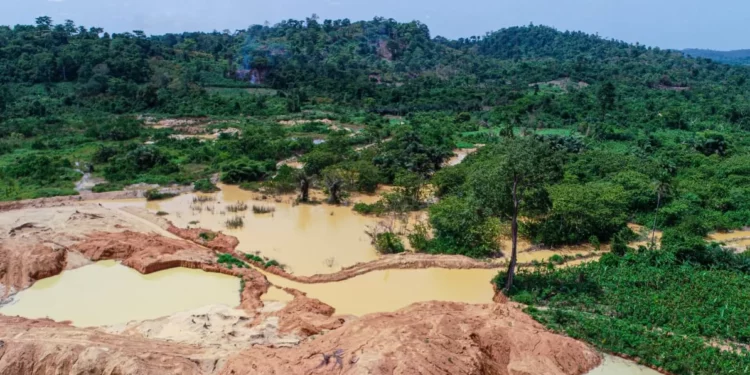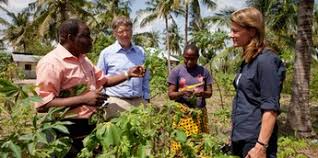Galamsey: The Silent Destroyer Of Ghana’s Youth Employment In Agriculture
INTRODUCTION
Galamsey, a term used to describe illegal small-scale mining in Ghana has become a significant threat to the country’s agricultural sector. The practice, which involves the use of simple tools and methods to extract gold and other minerals, has a devastating effect on the environments on the environment, including land degradation, water pollution, and loss of biodiversity (Schwartz Taylor &Taylor, 2018)
Ghana, a country renowned for its rich natural resources and agricultural prowess, faces a daunting challenge that threatens the foundation of its sustainable development. Galamsey, a local term for artisanal and small-scale mining has a scourge on the environment, economy, and society.
This clandestine industry, predominantly driven by youth seeking livelihoods, has devastating consequences on Ghana’s agricultural sector, exacerbating youth unemployment and undermining the country’s food security.
Agriculture, the backbone of Ghana’s economy employs approximately 50% of the workforce, contributing significantly to the country’s GDP (MoFA, 2020). However, galamsey activities have led to the widespread destruction of arable lands, water pollution, and loss of biodiversity, rendering once-fertile lands unstable for farming (Schwarts Taylor&Taylor, 2018). This does not only affect agricultural productivity but also jeopardizes the livelihoods of millions of youth dependent on farming.
GHANA’S YOUTH IN AGRICULTURE
Ghana’s youth population, aged 15-35, constitutes approximately 35% of the total population (GSS, 2020). Unemployment rates hovering around 12% (GSS, 2020), and many young people are forced to seek alternative livelihoods, including galamsey. Lured by promises of quick wealth, thousands of youths abandon their agricultural heritage, further exacerbating labour shortages in the sector.
Youth involvement in agriculture dates back to ancient civilizations, where farming was a family-oriented activity passed down through generations. Over time, the role of youth in agriculture has evolved significantly, influenced by social, economic, and technological advancements.
The 1980s saw a decline in youth involvement in agriculture, due to urbanization, lack of job opportunities, and limited credit (IFAD, 2019). However, recently there has been a decrease in youth participation in Agriculture in most regions of Ghana. This is a result of illegal mining and sand-wining activities in various parts of Ghana which the youth see as more income-generating than agriculture.
IMPACT OF GALAMSEY ON YOUTH EMPLOYMENT IN AGRICULTURE
Galamsey activities have a direct impact on youth employment in agriculture. The effects are multifaceted and can be seen in the following ways.
Labour shortages are one of the ways galamsay influences youth employment in Agriculture. The destruction of agricultural lands and water bodies due to galamsey activities leads to labour shortages in the agricultural sector. Many youths who could otherwise be employed in the sector are forced to seek alternative livelihoods, leading to a shortage of labor in the sector (Agyemang, 2019).
Low wages are another serious issues that affect youth employment in Agriculture. The scarcity of labour in the agricultural sector due to galamsey activities leads to low wages for young people employed in agriculture. Many young people are forced to accept low wages due to the lack of alternative employment opportunities (Owusu, 2020).
Poor working conditions is another means that impede youth employment in Agriculture. The destruction of agricultural lands and water bodies due to illegal mining activities leads to poor working conditions for youth employed in agriculture. Many young people are exposed to hazardous chemicals and poor sanitation leading to health problems (Kumi-Boateng, 2018)
ECONOMIC IMPACTS OF GALAMSEY ON YOUTH EMPLOYMENT IN AGRICULTURE
The economic impact of galamsey on youth employment in agriculture in Ghana is multifaceted. Galamsey has become a significant source of employment for many youths in Ghana, particularly in rural areas where alternative job opportunities are scarce.
The impact of galamsey on youth employment in agriculture has significant economic implications. The destruction of agricultural lands and water bodies leads to a decline in agricultural productivity, resulting in economic losses for young people employed in agriculture and the country as a whole (Arhin, 2024). This has therefore led to a decline in youth participation in agriculture.
SOCIAL IMPACTS OF GALAMSEY ON YOUTH EMPLOYMENT IN AGRICULTURE
The impact of galamsey on youth employment in agriculture also has significant social implications. The destruction of agricultural lands and water bodies leads to the placement of communities, resulting in social problems such as poverty, migration, and conflict (Agyemang, 2019).
Galamsey activities have led to widespread displacement of rural communities, forcing youth to migrate to urban centers in search of alternative livelihoods (Agyemang, 2019). This displacement results in social problems, such as poverty, crime, and family disintegration. The breakdown of traditional social structures and community networks exacerbates these issues.
Galamsey’s allure of quick wealth often leads youth to abandon their agricultural heritage, causing family disintegration (Amoah, 2019). Parents, who traditionally relied on their children for farm labour are left to manage farms alone, leading to reduced agricultural productivity. This breakdown in family relationships also affects social cohesion and community stability.
Galamsey activities have sparked social unrest and conflict and rural communities (Arhin, 2024). Competition for land, water, and resources leads to tensions between miners, farmers, and local authorities. Youth involvement in galamsey often fuels these conflicts, undermining social harmony and community relationships.
Once again illegal mining encroaches on agricultural lands threaten Ghana’s cultural heritage (Schwartz Taylor& Taylor, 2018). Traditional farming practices passed down through generations are being lost as youth abandon agriculture for galamsey.
RECOMMENDATIONS
The impact of illegal mining on youth employment in agriculture in Ghana is complex and multifaceted. The following are my detailed recommendations;
- Implementation of targeted poverty reduction programs in mining communities to help create alternative livelihood opportunities through training, subsidies, and access to credit in all affected communities in Ghana. In addition, the creation of entrepreneurship and small businesses in rural communities will also help to sustain agricultural activities in mining communities.
- Increase the profitability of agriculture through improved technology, market access, and value addition. The raising of awareness about the long-term environmental and social consequences of illegal mining by strengthening law enforcement and imposing stricter penalties for illegal mining.
- Allocation of sufficient resources to agricultural research and development to help promote sustainable farming practices to improve productivity and environmental sustainability. As well as investing in irrigation infrastructure to mitigate the effects of climate change to promote all-year farming throughout the season.
- Intensive vocational training programs in agriculture and agribusiness. This can be done by the Peasant Farmers Association of Ghana (PFAG) as well as other related civil society organization to increase the interest of agriculture in mining areas. They can provide mentorship and support to young farmers as well as encourage the youth to join the various farmer-based organizations in their communities.
- There must be easy access to market centers and value addition of agricultural products. Agricultural processing industries must be situated in communities to help add value to the farm products to increase prices which will make the youth feel equally good as being involved in galamsey.
- There must be collaborative efforts among the chief, elders, assemblymen, youth, and the entire community members in the fight against illegal mining since it can go a long way to destroy our natural resources, productive agricultural lands, destroy water bodies that can be used for all-round farming activities and as well as domestic activities.
CONCLUSION
Galamsey activities have devasting effects on youth employment in agriculture, leading to labour shortages low wages, poor working conditions, and economic and social losses. To address this issue, the government, stakeholders, and individuals must work together to enforce laws and regulations, provide alternative livelihoods for the youth in agriculture, rehabilitate degraded lands, and educate the public about the importance of agricultural youth employment against illegal mining in the communities,
REFERENCES
Agyemang, I. (2019). The impact of galamsey on Agriculture in Ghana. Journal of Sustainable Development, 12 (3), 1-12.
Amoah, P. (2019). Galamsey and its impact on Biodiversity in Ghana.
Journal of Environmental Science and Health, Part B, 54, 1-15.
IFAD (2019). Rural Development Report
Kumi-Boateng, B. (2018). Water Pollution from Galamsey Activities in Ghana. Journal of Water Resources and Protection, 10, 1-12.
Owusu, K. (2020). The economic Impacts of Galamsey on Agriculture in Ghana. Journal of Agricultural Economics, 71 (2), 1-15.
Schwartz Taylor, M., & Taylor, K. (2018). Ghana’s illegal Galamsey Gold Mining Affecting Cocoa Farmers, Chocolate Industry.







